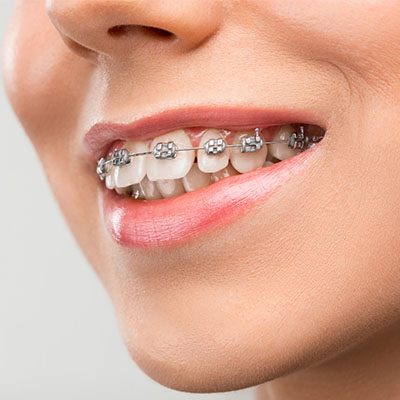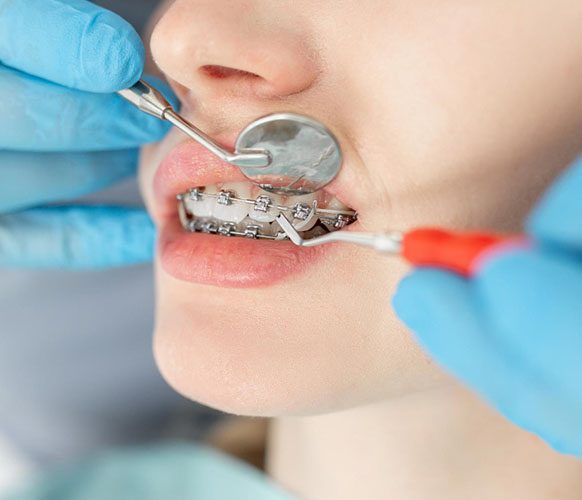Orthodontics
Orthodontics Thornton
 Dentistry’s orthodontics department adjusts abnormal bites and tooth spacing. Therapy aims to create healthy teeth and jaws by treating the alignment of the opposing teeth.
Dentistry’s orthodontics department adjusts abnormal bites and tooth spacing. Therapy aims to create healthy teeth and jaws by treating the alignment of the opposing teeth.
Understanding Orthodontics
Orthodontics focuses on diagnosing, preventing, and correcting dental and facial irregularities. These can include:
- Malocclusions: Misalignment of teeth, such as overbites, underbites, and crossbites.
- Crowding: Lack of space in the jaw, causing teeth to overlap.
- Spacing Issues: Tooth gaps resulting from missing teeth or other causes.
- Protrusion: Front teeth that stick out beyond the normal alignment.
- Jaw Misalignments: Problems with the positioning of the jaws, affecting bite function.
Dentists use a variety of appliances and techniques that they have been adequately educated to use for optimal alignment and functionality.
The Benefits of Orthodontic Treatment
Improved Dental Health
Positive effects on dental health are among the main advantages of orthodontic therapy. Poor cleaning techniques can exacerbate misaligned teeth, increasing the risk of cavities, gum disease, and plaque accumulation. Braces lower the likelihood of these dental problems by straightening teeth and adjusting the bite, making it simpler to practise excellent oral hygiene.
Enhanced Aesthetics and Self-Confidence
A straight, beautiful smile can significantly boost self-esteem and confidence. Many people feel self-conscious about their teeth when they are misaligned or protruding. Orthodontic treatment improves dental function and enhances facial aesthetics, helping individuals feel more comfortable and confident in their appearance.
Correcting Speech and Chewing Problems
Misaligned teeth and jaw discrepancies can sometimes lead to speech impediments and difficulty chewing food properly. Orthodontic interventions can help correct these issues, improving speech clarity and the ability to chew effectively.
Correcting the Jaws’ and Teeth’s Relationship
Braces may be required when the jaws do not meet adequately or when teeth are misaligned. Interceptive orthodontics can avoid specific spacing issues during tooth eruption and oral development. Retainers are used to maintain the outcomes of orthodontic treatment.
Orthodontic therapy can help you manage the following:
- TMJ disorders
- Oral hygiene
- Abnormal tooth wear
- Gum disease
Types of Orthodontic Treatments
Orthodontic treatments have evolved significantly, offering patients more options to achieve their desired results.

Some common treatments include:
- Traditional Braces: Metal brackets and wires gradually move teeth into place.
- Clear Aligners: Transparent, removable trays (such as Invisalign) that are custom-made to fit over teeth and gently shift them into alignment.
- Lingual Braces are brackets and wires attached to the back of teeth, making them less visible from the front.
- Functional Appliances: Devices used to correct jaw discrepancies and improve facial balance.
The therapy choice depends on the severity of the orthodontic issue, patient preferences, and dentist recommendations.
The Process of Orthodontic Treatment
Orthodontic treatment involves several key stages:
Consultation and Evaluation
A dentist conducts a comprehensive assessment, including a visual exam, photographs, X-rays, and teeth impressions. This evaluation helps develop a personalised treatment plan.
Treatment Planning
The dentist recommends the best treatment option (braces, aligners, etc.) and informs the patient about the treatment duration, outcomes, and costs.
Active Treatment Phase
Braces or aligners are placed, and regular follow-up visits ensure progress and necessary adjustments.
Retention Phase
After the active treatment, retainers are provided to maintain the teeth’s new positions. Patients must wear retainers as directed.
Follow-Up Care
Periodic visits monitor the stability of results. Maintaining the success of the treatment requires regular dental check-ups and good oral hygiene.
Orthodontics in Thornton
Start down the path to a more radiant and healthy smile.
Your Thornton, Maitland NSW dentist will work closely with you to find the perfect orthodontic treatment.
Call us on (02) 4966 2996 or book your appointment online today!
What is orthodontics?
Orthodontics corrects teeth and jaw alignment using braces or aligners.
When should I consider orthodontic treatment?
Consider orthodontics if you have crooked, crowded teeth or bite issues.
How do I know if I need braces?
For an evaluation, speak with your dentist.
What types of braces are available?
Metal braces, ceramic braces, lingual braces, and clear aligners (Invisalign)
How long does treatment take?
Typically, it is 12-24 months but varies per individual case.
Does orthodontic treatment hurt?
Some discomfort is expected but manageable with pain relievers.
Are there age restrictions for treatment?
No, treatment is effective for children, teens, and adults.
How often are orthodontic visits needed?
Every 4-6 weeks for adjustments.
What happens after treatment?
You’ll wear a retainer to maintain your new alignment.
Will it affect my daily life?
Yes, but adjustments to eating and hygiene routines will help.
